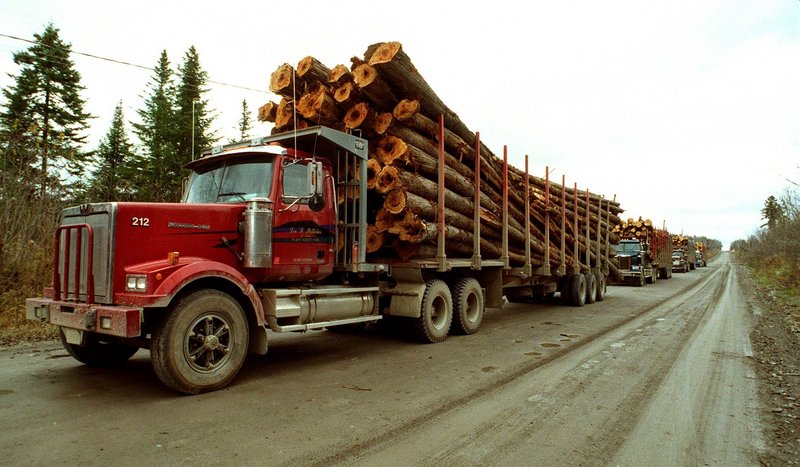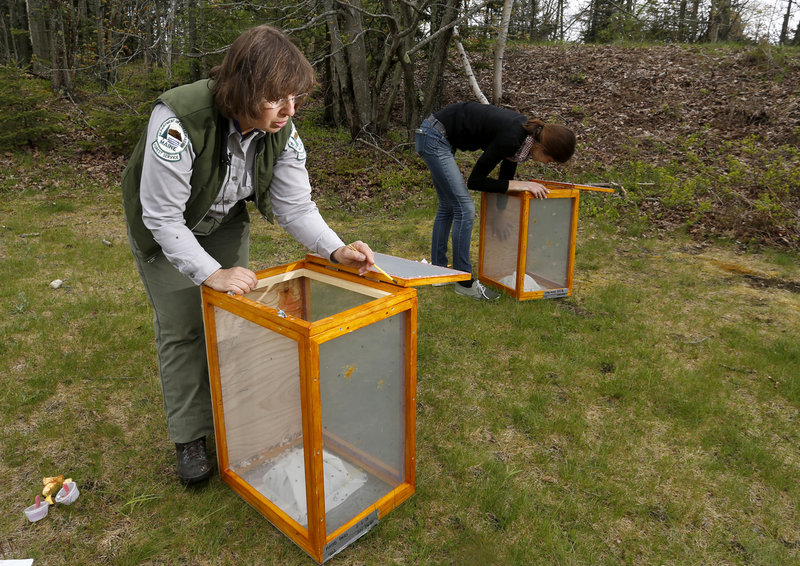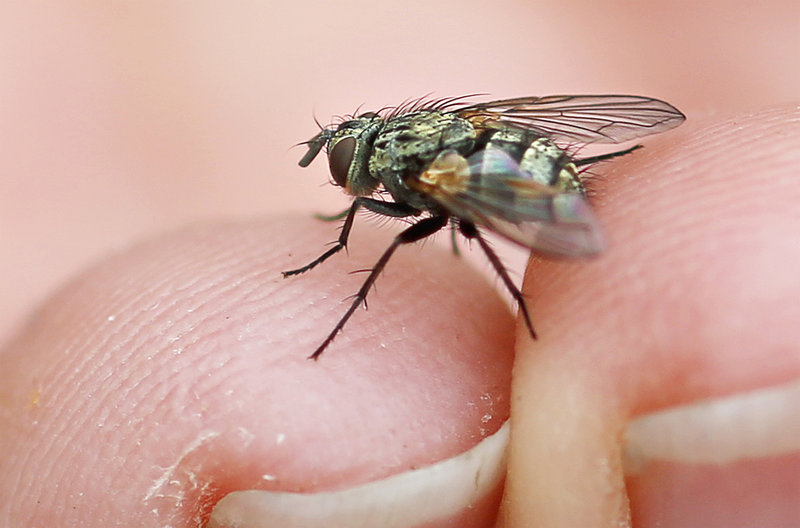Unless people dramatically cut the amount of carbon dioxide they’re putting into the air and water through industry, farming, landfills and fossil fuel consumption, Maine’s largest manufacturing industry will be damaged in ways scientists can only begin to predict.
That’s the conclusion reached by experts who are studying how climate change is likely to affect Maine’s more than 18 million acres of forests.
The nation’s most heavily forested state, Maine is likely to be in for a rude awakening in forestry within the next 20 to 100 years, state specialists predict. Which trees will flourish, and where, will change — gradually over time — and imperceptibly at first to most observers.
Which trees might disappear — literally migrating to reach more congenial growing conditions — and what the survivors will need to protect them from an erratic climate and a host of predators are questions researchers are trying to probe, knowing how difficult such projections can be.
But the implications are huge. In Maine, forests translate into a lot of land, money and jobs.
Maine’s forests generate more than $5 billion a year to the economy through the production of timber and wood products, including furniture, biomass pellets and paper pulp. When added to other forest-related businesses, including tourism and recreation, that number grows to about $6.5 billion for the state’s economy annually, according to the most recent reports from the North East State Foresters Association.
Twenty percent of homes are heated by wood, and more than 30,000 jobs are linked to forestry. Of those 30,000, 12,000 are tourism and recreation jobs tied to what has long been one of Maine’s great points of pride: its woodlands. Sales of Christmas trees, wreathes and maple syrup account for more than $10 million each year.
“Trees are the dominant life form,” said Dave Struble, state entomologist and head of the Forest Health and Monitoring Division of the state Department of Agriculture, Conservation and Forestry. “If you’re the dominant life form, and you’re put under stress and you change, (there’s) the chance of changing everything,” Struble said. “Trees are foundational. They’re the cornerstone of clean water, of habitat. That’s certainly true for Maine.”
The potential economic consequences of climate change have prompted many states to prepare plans or take action to mitigate the impacts. In Maine, the Department of Environmental Protection began working on a climate change plan in 2010.
But that work was suspended by Republican Gov. Paul LePage shortly after he took office. With Democrats back in control of the Legislature, a committee voted last week to resume work on the plan.
At this point, the visible impact of climate change in the Maine forest remains mostly subtle and the evidence anecdotal.
“It’s not something that jumps out at me,” said Mike Devine, state supervisor of forest health and monitoring. “I don’t see it in the north country.”
But Devine, who has worked the Maine woods for a half century, does notice that some things seem out of whack. Winters definitely are milder; he remembers the years when temperatures of minus 30 degrees were not uncommon. “And ice conditions are not what they used to be,” he said, an impression he’s had confirmed by many ice fishermen.
Then, too, this spring, trees in Bangor, he said, have been more advanced in budding and leafing out than in areas farther south — just the opposite of what one would expect, except that a changing climate is altering the landscape.
Trees cover 90 percent of the state, an area larger than West Virginia, extending from Kittery to Fort Kent and from Jackman to Lubec, according to the Maine Tree Foundation.
The woods of Maine are getting warmer, wetter and more vulnerable to disease and pests — thanks to the effects wrought by human-induced climate change, many state experts believe. By the year 2100 — when many young families’ grandchildren will reach old age — the changing climate will likely make temperatures 3 to 14 degrees Fahrenheit higher in winter and 3 to 11 degrees higher in summer, according to a 2010 study co-authored by six public agencies and nonprofit organizations in Maine.
Rain and snowfall are projected to rise 2 percent to 14 percent, with the greatest changes occurring in all seasons but summer. The growing season is expected to be prolonged by one to two days per decade, and the sea level to be higher by 5 to 15 inches or more. Coastal waters, already warmer and more acidic, could increase another 10 degrees Fahrenheit.
And carbon dioxide concentrations — the fuel that keeps climate change going — are predicted to double by the beginning of the next century. Late last week, climate scientists announced that for the first time in at least 800,000 years, the global measure of carbon dioxide has passed 400 parts per million — considerably more than the 350 ppm ceiling that has been designated by many climatologists as the maximum for the survival of the planet. The amount of atmospheric carbon dioxide is not constant; it varies throughout the year, and scientists do not believe the 2013 average will exceed the 400 ppm level.
SIGNS OF TROUBLE
Even so, most climate experts say it is not good news.
Woodlands are so vast that signs of trouble — thinning stands, pests, disease, problems with root systems or the defoliation of leaves — can remain hidden for a time. Stresses on trees tend to be less obvious and immediate than the disturbing, evident changes that fishermen, for example, are witnessing in the Gulf of Maine. But “things are happening already, especially where things are under stress and in the edges or margins of types of forest,” Struble said. “It’s at the disturbed edge where you see it first.”
“Not everybody can be winners,” he said. “There’s only so much water, so much soil, so much light.”
“We’re getting different diseases and different pests than we did in the past,” Struble said. These changes alter the competitive capacity of species such as fir, spruce and hemlock.
Maine lies in a transition zone between the eastern temperate forest to the south and boreal forest to the north. A swath between the two zones, the state could manifest climate change at both edges, affecting the forests here more dramatically than in other areas of New England.
Most of the estimated half-million acres of forest harvested annually in Maine regenerate themselves naturally, rather than by replanting. Red maple trees often renew themselves by sprouting, for example, sending up new shoots around the base of the trunks.
But others — sugar maple, spruce and fir — rely on the natural spread of seed to replace harvested trees. Without management — help from human beings — this process can be slow, its success in doubt. And if seed dissemination is interrupted or thrown off-kilter, those trees would take the blow.
The uncertain fate of young trees — the next generation and the next — might turn out to be one of the most pronounced effects of climate change, Struble said. Immature trees are vulnerable anyway, but they suffer particularly under the avalanche of problems that climate change can bring. Those problems include disease, insect pests, and invasive or exotic species.
Scientists generally agree that climate change will bring a cascade of consequences over the next century: warmer temperatures, more intense rainfall in greater amounts; shorter, warmer winters; more dramatic swings in weather and climate-affected events such as crippling blizzards, sweeping forest fires and devastating drought.
“I think there’s fairly good agreement that in Maine we’ll be facing a warmer and wetter climate,” said Struble. “But I think it’s going to be chaotic until things stabilize.”
Ironically, some effects — rising temperatures leading to longer growing seasons and greater precipitation — will likely improve tree-growth potential, scientists agree. But not for all varieties. The stands of trees people see today are not likely to be the forests that dominate in the not-so-distant tomorrow.
“There won’t be much change initially,” said Struble, because Maine’s forests are populated by mature and resilient long-lived varieties. “Trees themselves will change very slowly; the types will change rather slowly. Trees don’t shift that fast, but insects and diseases, they do.”
WINTER MOTHS
The range, distribution and severity of many pests is climate-controlled, Struble said. For example, the Eastern spruce budworm, one of the most destructive native insects in the northern spruce and fir forests, was first identified in the U.S. in 1807 in Maine and still is seen throughout the northern two-thirds of the state. In its larval stage, it bores into and feeds on needles and buds, finally defoliating the tree.
Its numbers and impact tend to drop off as the insect reaches colder regions toward Hudson Bay. But if temperatures continue to rise here, its range will likely stretch farther north, encompassing more and more of the North Woods.
The southern boundary of the pest might shift northward, too, particularly if winter weather doesn’t get cold enough to trigger hibernation, a resting phase essential to the insect’s survival.
Non-native invasive pests and diseases already here also appear to be expanding their range.
One obvious sign of the penetration into Maine of formerly unknown pests turned up as clouds of white moths in late fall and early winter last year. Winter moths, which descended on communities by the thousands, have spread here from southern New England, where they have been seen in swarms for many years.
“At this time, the big thing is winter moth,” said Charlene Donahue, a Maine Forest Service entomologist. “It’s in your face, in your trees.”
The moth is active, right now, in its larval form, as caterpillars in buds, she said. Within the next few weeks, people will begin to see some defoliation of trees and bushes, including apples, blueberries and cranberries.
Last week, state entomologists from the forestry division of the Maine Department of Agriculture, Conservation and Forestry began releasing parasitic flies in Cape Elizabeth and Harpswell to try to control and minimize the damage to trees and shrubs done by the moth, said Donahue.
It will be years before entomologists know whether the flies have brought the winter moth under control, but they are hopeful. The moths were used successfully in Nova Scotia in the 1960s, halting the infestation and manifesting no adverse effects over the last 50 years, state entomologists said.
But the clouds of winter moths — like the continuing spread northward of the hemlock woolly adelgid that attacks both landscape trees and forests — are signs that weather can have a huge impact on all sorts of vegetation.
“We’re not going to end up with an ecological desert,” Struble said. “But the reason to be concerned is that (with climate change), you’re going to simplify things for a period of time, and if it gets too simple, it’s not as stable. We don’t really thrive when things are in collapse. … It’s about having time to adapt to things as things change.”
North Cairn can be contacted at 791-6325 or at:
ncairn@mainetoday.com
Send questions/comments to the editors.





